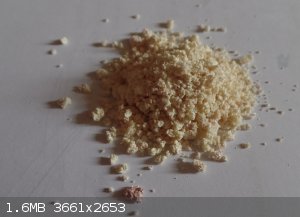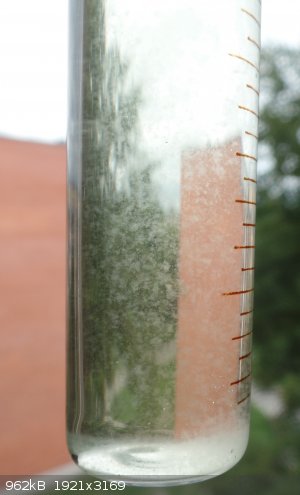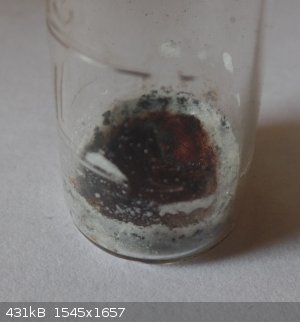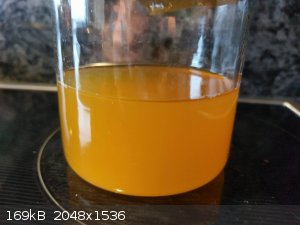| Pages:
1
2
3
..
5 |
TheMrbunGee
Hazard to Others
  
Posts: 364
Registered: 13-7-2016
Location: EU
Member Is Offline
Mood: Phosphorising
|
|
What is this Chemical?
Hello!
Recently I got my hands on many old chemicals, I sorted them out, but few were without any labels, and i could not figure out what they are.
I was wondering if You may want to play a game. I can show you the chemical and do any requested tests and together we could solve this puzzle!
I have a bunch of them but we could start one by one.

|
|
|
TheMrbunGee
Hazard to Others
  
Posts: 364
Registered: 13-7-2016
Location: EU
Member Is Offline
Mood: Phosphorising
|
|
So this is first chemical. This should be pretty easy one. (pic. in first post attachment)
It is pale yellow, highly water soluble solid.
I think there is chromium in there somewhere. Its water solution reacts with sulfuric acid and forms less soluble salt, which is also yellowish white,
but when suspension is diluted with more water it forms clear blue solution.
[Edited on 13-7-2016 by TheMrbunGee]
[Edited on 13-7-2016 by TheMrbunGee]
|
|
|
CRUSTY
Hazard to Others
  
Posts: 138
Registered: 5-6-2016
Location: Nearby
Member Is Offline
Mood: High-Order
|
|
Were any gases produced in the reaction with H2SO4?
[Edited on 13-7-2016 by CRUSTY]
|
|
|
TheMrbunGee
Hazard to Others
  
Posts: 364
Registered: 13-7-2016
Location: EU
Member Is Offline
Mood: Phosphorising
|
|
No.
Adding hydrogen peroxide to the blue solution makes it green.
[Edited on 13-7-2016 by TheMrbunGee]
|
|
|
Panache
International Hazard
    
Posts: 1290
Registered: 18-10-2007
Member Is Offline
Mood: Instead of being my deliverance, she had a resemblance to a Kat named Frankenstein
|
|
Definitions
I do believe new, hitherto undiscovered or imagined, levels of inanity (is that even a word!!!) are possible in this thread.
That may be the most derisive and
snide I have ever been. I quite like it.
|
|
|
Panache
International Hazard
    
Posts: 1290
Registered: 18-10-2007
Member Is Offline
Mood: Instead of being my deliverance, she had a resemblance to a Kat named Frankenstein
|
|
Ok a serious answer.
If it is important, go get a $12 same day gcms run on the sample. If it's not important and just of interest to you i could get a oijua board and try
and channel some chemists from the 19th century. They may be of assistance.
Omgwtfpnt!!!
|
|
|
Metacelsus
International Hazard
    
Posts: 2531
Registered: 26-12-2012
Location: Boston, MA
Member Is Offline
Mood: Double, double, toil and trouble
|
|
GC-MS won't help if it's an inorganic salt. Yes, inanity is a word.
My best guess is an anhydrous chromium(ii) salt, based on the color change you reported after adding peroxide (which would reflect oxidation to
chromium(iii)). However, there's really not enough information to characterize it at this point.
|
|
|
Texium
Administrator
       
Posts: 4508
Registered: 11-1-2014
Location: Salt Lake City
Member Is Offline
Mood: PhD candidate!
|
|
I doubt that it's a chromium(II) salt. They are so easily oxidized that if this is an old chemical as the OP says, it should already be highly
discolored unless it has been in a sealed, unopened container this whole time. It could be something organic.
|
|
|
BromicAcid
International Hazard
    
Posts: 3227
Registered: 13-7-2003
Location: Wisconsin
Member Is Offline
Mood: Rock n' Roll
|
|
Your first picture shows a bit of a sheen on the solids, is it deliquescent?
|
|
|
TheMrbunGee
Hazard to Others
  
Posts: 364
Registered: 13-7-2016
Location: EU
Member Is Offline
Mood: Phosphorising
|
|
No, the container in which this chemical was stored did not have a good seal and the top of the clumped powder looked like it had shrinked a bit, but
it was still a solid!
| Quote: | I doubt that it's a chromium(II) salt. They are so easily oxidized that if this is an old chemical as the OP says, it should already be highly
discolored unless it has been in a sealed, unopened container this whole time. It could be something organic.
|
When I was removing it from the container there was a cherry sized part in the middle of substance orangey-brownish colored. But everything else
looked good. The crystals are at least 30 years old.
| Quote: | However, there's really not enough information to characterize it at this point.
|
If You Think of any test I might do - let me know and I’ll do them! 
[Edited on 16-7-2016 by TheMrbunGee]
[Edited on 16-7-2016 by TheMrbunGee]
|
|
|
Panache
International Hazard
    
Posts: 1290
Registered: 18-10-2007
Member Is Offline
Mood: Instead of being my deliverance, she had a resemblance to a Kat named Frankenstein
|
|
Ok reread my nasty posts from last night
I was a little bit drunk, I am sorry for being so unhelpful.
Attempt to take a small, like 50mg, to red heat using any air aspirated flame (ie Bunsen burner, jet lighter ) in a small test tube that you have just
already taken to red heat and let cool.
If the substance is organic all carbon will be oxidised to co2 at this temperature and it should completely disappear.
If it doesn't you now have a good/reasonable chance of characterising it.
If it does you now need an accurate melting point, assuming it melts before it decomposes) and a wolfram alpha account ($5) I think)
Do the heat thing and I'll let you know an easy way to do an accurate melting point at home
|
|
|
DraconicAcid
International Hazard
    
Posts: 4278
Registered: 1-2-2013
Location: The tiniest college campus ever....
Member Is Offline
Mood: Semi-victorious.
|
|
If it's water soluble, check the pH of the solution. Also see if the aqueous solution reacts with sodium hydroxide, and if it dissolves in acetone.
Please remember: "Filtrate" is not a verb.
Write up your lab reports the way your instructor wants them, not the way your ex-instructor wants them.
|
|
|
hyfalcon
International Hazard
    
Posts: 1003
Registered: 29-3-2012
Member Is Offline
Mood: No Mood
|
|
Flame test would give you and idea of the Anion.
|
|
|
DraconicAcid
International Hazard
    
Posts: 4278
Registered: 1-2-2013
Location: The tiniest college campus ever....
Member Is Offline
Mood: Semi-victorious.
|
|
Flame tests are usually better for cations, and only a few of them.
Please remember: "Filtrate" is not a verb.
Write up your lab reports the way your instructor wants them, not the way your ex-instructor wants them.
|
|
|
TheMrbunGee
Hazard to Others
  
Posts: 364
Registered: 13-7-2016
Location: EU
Member Is Offline
Mood: Phosphorising
|
|
Quote: Originally posted by Panache  | Ok reread my nasty posts from last night
I was a little bit drunk, I am sorry for being so unhelpful.
Attempt to take a small, like 50mg, to red heat using any air aspirated flame (ie Bunsen burner, jet lighter ) in a small test tube that you have just
already taken to red heat and let cool.
If the substance is organic all carbon will be oxidised to co2 at this temperature and it should completely disappear.
If it doesn't you now have a good/reasonable chance of characterising it.
If it does you now need an accurate melting point, assuming it melts before it decomposes) and a wolfram alpha account ($5) I think)
Do the heat thing and I'll let you know an easy way to do an accurate melting point at home |
I did the heating test and it did melt in about 600-700 C, It did not decompose, but I think it changed a little bit. When melted it is a dark
orange/brown liquid, and it seems to boil (small bubbles comes out from molten salt) After cooling about 15% of it undissolved, but I melted a hole in
my test tube so solution leaked off.. (After cooling down substance dad changed color (Grey on the sides, where the temperature was higher and
brown/orange in the center) (right picture below)
| Quote: |
If it's water soluble, check the pH of the solution. Also see if the aqueous solution reacts with sodium hydroxide, and if it dissolves in acetone.
|
pH Is close to neutral, It is not soluble in acetone and doesn’t seem to react with NaOH, although I noticed a really small amount of sludge in the
mixture of two (Left picture)
May be it has some impurities.
 
[Edited on 17-7-2016 by TheMrbunGee]
|
|
|
NEMO-Chemistry
International Hazard
    
Posts: 1559
Registered: 29-5-2016
Location: UK
Member Is Offline
Mood: No Mood
|
|
Maybe Lead (II) oxide?
|
|
|
Neme
Hazard to Self
 
Posts: 86
Registered: 28-5-2016
Location: Czech republic
Member Is Offline
Mood: No Mood
|
|
Lead (II) oxide is insoluble in water.
|
|
|
TheMrbunGee
Hazard to Others
  
Posts: 364
Registered: 13-7-2016
Location: EU
Member Is Offline
Mood: Phosphorising
|
|
does Pb even form blue salts?
|
|
|
clearly_not_atara
International Hazard
    
Posts: 2691
Registered: 3-11-2013
Member Is Offline
Mood: Big
|
|
If you have enough of the substance and a heating element, you can try carbothermal reduction as a way to possibly extract any metals in it. This
won't work for all metals -- and it can produce toxic carbon monoxide -- but it gives us an opportunity to narrow the possibilities down a lot. Heat
the salt with powdered carbon at 1000 C or so or until it melts; see if any metallic residue is produced, and if so, you can begin checking for
solubility.
You can also go the other way by passing ozone through an aqueous solution of this salt. This will take most metals to their highest oxidation state,
which at least aids colorimetry.
|
|
|
NEMO-Chemistry
International Hazard
    
Posts: 1559
Registered: 29-5-2016
Location: UK
Member Is Offline
Mood: No Mood
|
|
Then i guess its not!
|
|
|
TheMrbunGee
Hazard to Others
  
Posts: 364
Registered: 13-7-2016
Location: EU
Member Is Offline
Mood: Phosphorising
|
|
Quote: Originally posted by clearly_not_atara  | If you have enough of the substance and a heating element, you can try carbothermal reduction as a way to possibly extract any metals in it. This
won't work for all metals -- and it can produce toxic carbon monoxide -- but it gives us an opportunity to narrow the possibilities down a lot. Heat
the salt with powdered carbon at 1000 C or so or until it melts; see if any metallic residue is produced, and if so, you can begin checking for
solubility.
You can also go the other way by passing ozone through an aqueous solution of this salt. This will take most metals to their highest oxidation state,
which at least aids colorimetry. |
I think it is most likely chromium salt.
Solutions mixed with:
HCl makes clear Blue solution;
HNO3 makes in the beginning greenish solution, wich turns brown and unclear;
Ammonia - nothing changes.
|
|
|
DraconicAcid
International Hazard
    
Posts: 4278
Registered: 1-2-2013
Location: The tiniest college campus ever....
Member Is Offline
Mood: Semi-victorious.
|
|
A chromium salt with that pale yellow colour?
If it is a chromium salt, then heating it with hydroxide and peroxide will give chromate, which can be easily tested for.
Please remember: "Filtrate" is not a verb.
Write up your lab reports the way your instructor wants them, not the way your ex-instructor wants them.
|
|
|
Sulaiman
International Hazard
    
Posts: 3555
Registered: 8-2-2015
Location: 3rd rock from the sun
Member Is Online
|
|
before using up / damaging your sample,
you could re-crystalise it from water,
maybe it will be more recognisable than the mass of crystals crashed out,
and you wil have a purer sample of compound-x
EDIT: there may be the original compound and/or decomposition products such as oxide/hydroxide/carbonate... that would confuse the isimple
dentification of the original compound.
[Edited on 20-7-2016 by Sulaiman]
|
|
|
TheMrbunGee
Hazard to Others
  
Posts: 364
Registered: 13-7-2016
Location: EU
Member Is Offline
Mood: Phosphorising
|
|
| Quote: |
If it is a chromium salt, then heating it with hydroxide and peroxide will give chromate, which can be easily tested for.
|
It did not gave chromate, but H2O2 decomposed (@ moderate rate).
Quote: Originally posted by Sulaiman  | before using up / damaging your sample,
you could re-crystalise it from water,
maybe it will be more recognisable than the mass of crystals crashed out,
and you wil have a purer sample of compound-x
EDIT: there may be the original compound and/or decomposition products such as oxide/hydroxide/carbonate... that would confuse the isimple
dentification of the original compound.
[Edited on 20-7-2016 by Sulaiman] |
I started recrystallizing the compound, managed to dissolve 100g of compound in 170 ml of boiling water (58-59g/100ml 100C), hot filtered out and
slowly lowering the temperature to maybe find out the crystal shape.
| Quote: |
A chromium salt with that pale yellow colour?
|
saturated solutions are quite dark orange..(picture)

[Edited on 21-7-2016 by TheMrbunGee]
|
|
|
Sulaiman
International Hazard
    
Posts: 3555
Registered: 8-2-2015
Location: 3rd rock from the sun
Member Is Online
|
|
IMO that is a suspension, not a solution which would be clear,
filter the suspension and crystalise the filtrate
How embarrassing that the combined brains of SM can't help identify an inorganic compound 
|
|
|
| Pages:
1
2
3
..
5 |